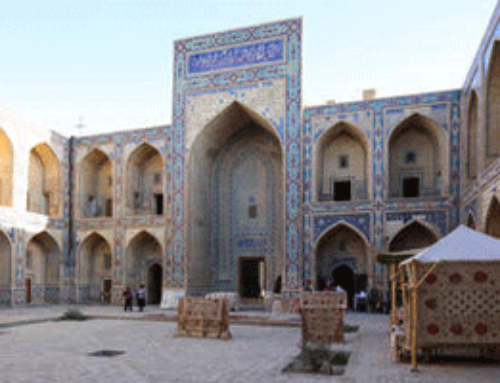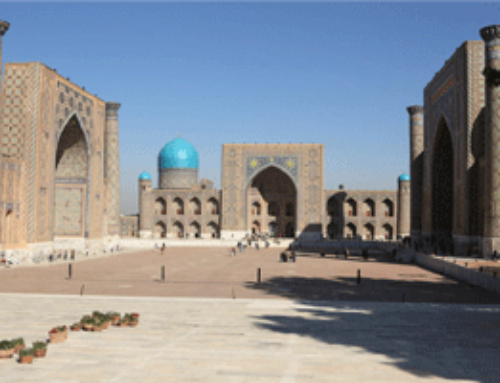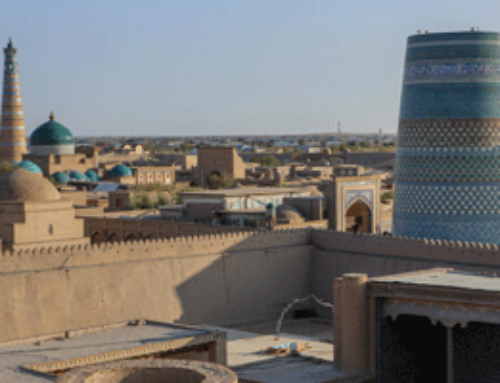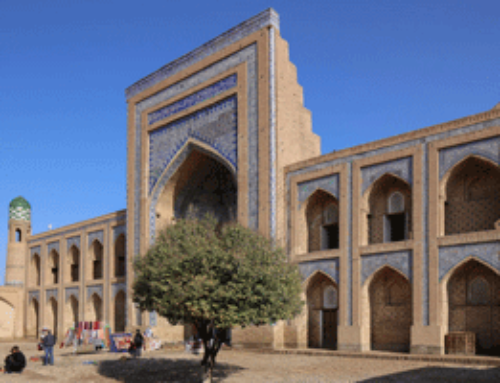The tour includes the following cities:
Tashkent, Samarkand, Shakhrisabz, Bukhara, Khiva, Nukus, Margilan
15 Day Craft Tour throughout Uzbekistan
Day 1. Tashkent.
Late evening arrival in Tashkent. After being met in the airport you will be transferred to your hotel for an overnight in Tashkent. (1st of 2 nights).
Day 2. Tashkent.
This morning you will visit the Khast-Imam Square, the old quarter of Tashkent where you will see an 8th century Koran which was brought to Central Asia by Tamerlane in the 15th century. On the square you will also see some glorious buildings and beautiful turquoise-tiled domes lighted like an exotic stage set.
The next visit of the day will be to the workshop of one of the most talented Tashkent embroidery artist, Madina Kasimbaeva. Madina is famous for her traditional dark red “Palak” (“Universe”) designs. The specialists of the Santa-Fe Folk Art Market* consider hers to be the best of all the other embroidery pieces presented in the Market.
*The Santa-Fe Folk Art Market is an extremely prestigious and internationally renowned annual craft fair which hosts crafts people from all over the world including many from Uzbekistan.
Later you will visit the Museum of Applied Arts to see magnificent suzanis (embroidered panels) and other fine crafts, the Abdul-Khasim Madrassah with its hujra (student dormitories) which are now used as metalwork craft workshops producing jewelry, miniature paintings, papier-mâché lacquered boxes and other goods.
After lunch at an excellent local restaurant, you’ll visit the Chor-Su Market – the biggest market in Tashkent. You will walk through the market and see rows of artists making craft items for daily needs, the place where dairy products and dry cheese are sold, the butchers’ area, the market for fresh fruits and vegetables, the bread bakeries, and the “food court” of freshly made lunches where people can order their meal and eat on site.
Continuing the day, you’ll have an opportunity to visit Muhayo Alieyava’s studio called “Bibi-Hanum”. This retail design studio specializes in contemporary apparel using Uzbek textiles. Mauhayo’s embroidery creations can be found in elegant galleries in the USA, Europe and all over the world. She is also a participant in the Folk Art Market in Santa-Fe.
The final visit of the sightseeing tour will be to the private studio (with museum & workshop) of Akbar Rakhimov, a local potter and one of the finest ceramic artists in the country.
Dinner and overnight in Tashkent. (2nd of 2 nights).
Day 3. Tashkent – Samarkand.
In the morning you will drive to Samarkand, the grand capital of the emperor Tamerlane (the brilliant and great 15th centure ruler who created a huge empire which spanned from Western China to Eastern Europe, including Persia, Turkey, and the Caucasus. Tamerlane made Samarand as his Imperial Capital).
The famous Silk Road went through Tashkent, the Sirdarya Region and the mountainous countryside of the Jizzah Region. You will have lunch in a picturesque roadside choi-khona (Tea House/Café).
After arriving and checking into the hotel, the sightseeing program in Samarkand will begin.
You will be driven out to see the Shaki-Zinda ensemble of the Mausoleums. This unusual necropolis has monuments from the 14th and 15th centuries, reflecting the development of the monumental art and architecture of the Timurid dynasty.
The name Shakhi-Zinda (meaning “The living king”) is connected with the legend that Kusam-ibn-Abbas, a cousin of the prophet Muhammad, is buried here. He came to Samarkand with the Arab invasion in the 7th century to preach Islam. Popular legends recount that he was beheaded for his faith, but he didn’t die. It is believed that he took his head and went into a deep well (the Garden of Paradise), where he’s still living now.
The Shakhi-Zinda complex was formed over eight centuries (from the 11th till 19th) and now includes more than twenty buildings. The ensemble comprises three groups of structures: the lower, middle and upper, connected by four-arched domed passages locally called chartak. The earliest buildings date back to the 11-12th centuries. Of the tombstones, mainly their bases and headstones have remained. The majority of the monuments date back to the 14-15th centuries.
The culmination of your first day in Samarkand will be a visit to the workshop of Valentina Romanenko, a famous textiles and garment designer. Valentina and her models will present a dramatic fashion show of garments made of locally hand woven, hand painted and hand embroidered silk fabrics which seem to float on the models. This workshop has a great collection of garments for sale.
Dinner and overnight in Samarkand. (1st of 2 nights).
Day 4. Samarkand.
After breakfast a visit will be paid to the most magnificent architectural complex in the whole of Uzbekistan – Registan Square. It is a breath-taking masterpiece construction, comprised of three sparkling tile madrassahs (Islamic schools) built in the 14th – 16th centuries. Tamerlane is quoted as having said “Let our enemies know our strength by witnessing the supremacy of our architecture”. Continue the sightseeing program to the glistening Gur-Emir mausoleum, where Tamerlane is buried. The beauty and elegance of the interior of this mausoleum will astound you.
You will then visit a paper making workshop located in a nearby village. The paper is made from the bark of mulberry trees. This craft was widespread in the Samarkand area in 16th – 19th centuries. When factory made paper arrived at the end of 19th century however, this craft died and was nearly forgotten.
After a delicious lunch you will visit Bibi-Khanum, the remains of the largest and most magnificent mosque in Samarkand, and once the entire Islamic world. Built in the 16th century this mosque is one of the most important monuments of Samarkand. By the mid of 20th century however, only a grandiose ruined bit of it still survived. Fortunately, major parts of the mosque were restored during the Soviet period.
After his Indian campaign in 1399 Timur (Tamerlane) decided to undertake the construction of a gigantic mosque in his new capital, Samarkand. From the beginning of the construction, problems of structural integrity revealed themselves. Various reconstructions and reinforcements were undertaken in order to save the mosque. However, after just a few years, the first bricks had begun to fall out of the huge dome over the mikhrab (the niche indicating the direction to Mecca). The scale of Timur’s plans pushed the building techniques of the time over their limit, and the building’s integrity was not helped by the rushed nature of its construction.
Continue to the nearby Siyob Market (or Bazaar) adjacent to the Bibi-Khanym Mosque. It is the largest bazaar in Samarkand. All daily necessities, such as “Samarkand naan” (bread), are sold in this bazaar which is visited not only by local people but also by domestic and foreign tourists.
Then you will visit the remains of the medieval world’s best and most remarkable observatory developed by Tamerlane‘s brilliant and learned grandson, Ulugbek. Although originally part of a three-story observatory and a 30 meter-high (90 feet) marble astrolabe for observing the positions of the stars, only the astrolabe’s under-ground semicircular track remains.
Ulugbek discovered 200 previously unknown stars with this instrument, and his calculations as to the length of the year have been shown to be amazingly accurate. In the small museum next door you will learn more about Uzbek astronomers.
In the early evening you’ll visit a silk carpet weaving workshop run by an Afghan family and meet the manager of this workshop Abdullah Badghisi. Abdullah is a medical doctor who is Turkmen by birth but a citizen of Afghanistan and lives in Uzbekistan. He is a polyglot like no other! He speaks 8 languages very fluently. He continues the ancient carpet making tradition of his father and grandfather. In the workshop you will see how local weavers create age-old, colorful and complex patterns using silk and wool yarns.
Dinner and overnight in Samarkand. (2nd of 2 nights).
Day 5. Samarkand – Shakhrisabz – Samarkand.
This morning be prepared for a full-day excursion which will take you to the once-magnificent Shakhrisabz, the 1336 birthplace of Tamerlane. Here you will visit the remains of the Ak Saray (White Palace), Tamerlane’s monumental summer residence complex which took 24 years to build. Unfortunately, all that is now left of this complex are remnants of the 40 meters (120 feet) high entrance covered with filigree-like mosaics. Continue to the mausoleum of Jehangir, Tamerlane’s son, one of the few remaining remnants of the Kok-Gumbaz ensemble which some say was even grander than the Ak-Saray (White Palace). A few streets further you will come to the Kok-Gumbaz (Blue Dome) Friday mosque completed by Ulugbeg in 1437 in honor of his father, Shakhrukh (Timur’s son). You will then visit the Dorut Tilavat (House of Meditation) Madrassah and the Shamseddin Kulyal Mausoleum which was completed by Tamelane in 1374.
After lunch you will visit the workshop of Gulnara Odilova noted for her many colorful and carefully embroidered items, such as pillow covers, bags of all sizes, and carpets. She uses a very traditional and authentic needle-point technique which is typical for the Shakhrisabz area.
Return to Samarkand for dinner and overnight. (3rd of 3 nights).
Day 6. Samarkand – Bukhara.
After breakfast depart Samarkand by bus as you continue tracing the Silk Route to holy Bukhara by the Royal Road (one of the most important parts of the Silk Route connecting Samarkand and Bukhara).
On the way you will see the ruins of the Rabat-Malik Caravansaray (an Inn for caravans); constructed along the Silk road in 11th century according to the orders of a son of one of Samarkand’s rulers. The portal of the caravansaray is one of the most ancient among the Central Asia portals. It has an inscription engraved by unknown masters which reads “the monument was built by the Sultan of the World and this ruinous place (the Malik Steppe territory) became well-furnished…”.
100 meters (300 feet) from the caravansaray there is a giant dome covered tank named Sardoba Malik. This is a 13 meters (40 feet) diameter storage reservoir which was built in the 11th century specifically to supply the Rabat-Malik Caravansaray with water. Water to the tank was fed by the Zaravshan River through an underground canal and was kept there for the whole summer. The water there was clean and cold owing to the dome, protecting it from the heat of the sun.
Stop in Gijduvan to visit the most important ceramic center of the Bukhara region. If you are lucky, you’ll have the opportunity to see the centuries old tradition of using a donkey for turning the millstones during the process of grinding natural dyes. Lunch is at a local potter’s home. Continue on an afternoon drive to Bukhara for a late afternoon arrival.
Dinner and overnight in Bukhara. (1st of 3 nights).
Day 7. Bukhara.
Today you will experience a tour beginning from the remarkable architectural masterpiece, the Ismail Samani Mausoleum, dating from the early 10th century. This Mausoleum is located in the North-Western part of Bukhara, just outside its historic center. The mausoleum is considered one of the iconic examples of early Islamic architecture and is known as the oldest funerary building of Central Asia. This mausoleum is in extraordinarily good condition as it was protected for centuries having been covered by desert sands. It was built as the resting place of the powerful and influential Islamic Samani family dynasty which ruled from approximately 900 to 1000. The Samanids established their de facto independence from the Abbasid Caliphate in Baghdad
and ruled over some areas covered by the modern day countries of Iran, Afghanistan, Uzbekistan, Tajikistan, and Kazakhstan.
Perfectly symmetrical, compact in its size, yet monumental in its structure, the Mausoleum not only combined multi-cultural building and decorative traditions, such as Sogdian, Sassanian, Persian and even Classical, but also introduced the squinch, an innovative dome support solution. It also incorporated features customary for medieval Islamic buildings – circular domes and mini domes, pointed arches, elaborate portals, columns and intricate geometric designs.
The Bolo-Khauz Mosque built by order of the Emir of Bukhara in the 17th century will be the next stop on your Bukhara tour. This historical mosque was built on the opposite side of the citadel of the Ark in the Registan district. It served as a Friday mosque during the time when the emir of Bukhara was being subjugated under the Bolshevik Russian rule in 1920s. Thin columns made of painted wood were added to the frontal part of the iwan (terrace) buit in 19th century, additionally supporting the roof of summer prayer room. The columns are decorated with colorful muqarnas (stalactites).
Your tour will include a visit to the 2000 year-old massive Ark (Fortress) where the Bukhara Emirs once lived. In addition to being a military structure, the Ark encompassed what was essentially a town that, during much of the fortress’ history, was inhabited by the various royal courts that held sway over the region surrounding Bukhara. The Ark was used in this manner until it fell to Russia in 1920. Currently, the Ark is an attraction for visitors and houses museums covering its history.
Continue to the home of a former merchant which is located in the Jewish quarter of Bukhara. The house was built in the 19th century and is now carefully preserved by owners, Akbar and Mastura. They also own a textile gallery which is nearby and contains masterpieces of embroidery, carpets and fabrics. Their merchandise is so unique that it is in the league of any Textile museum collection.
After lunch continue your sightseeing to visit Poi-Kalon, or “Pedestal of the Great”, the heart and focal point of all Bukhara. You will also visit the madrassahs of Ulugbek and Abdul-Aziz Khan and the 16th century Magoki-Attori mosque, dating from 12th century. Your visit will include the Lyabi-Khaus (otherwise known as the Shore of the Pool), an architectural complex consisting of a 16th century madrassah and a mosque and the nearby dome covered markets. Over its history, more than 300 mosques (large and small) have been built in Bukhara, many of which still remain.
In the evening enjoy a concert and program at the Nodir-Divan Begi Madrassah. The program includes Uzbek national music and dance combined with a fashion show of contemporary garments made of traditional textiles. After the concert you will have an opportunity to Irina Sharipova, meet a costume designer and visit her workshop which is in the same madrassah. If you are interested in her works, they are for sale.
Dinner and overnight in Bukhara. (2nd of 3 nights).
Day 8. Bukhara.
Today you will be driven 12 km. into the countryside to begin a sightseeing visit at the Memorial Complex of Bakhouddin Naqshbandi, one of the most important Muslim shrines. Every self-respecting Muslim knows and reveres the name of this great theologian of the 14th century, and founder of the Sufi Order “Naqshbandia”.
Bakhouddin Naqshbandi appealed to people to be modest and reject luxury. His philosophy was based on the principle: “Dil ba joru, dast ba kor” (“The heart should be with the God, and hands at work”). The main building of the complex is the khanqah (dormitory for dervishes). In front of the mosque there is a minaret and small madrassah. In a separate courtyard there is a large necropolis, where Naqshbandi is buried. The Mausoleum of Bakhouddin Naqshbandi is considered to be the Central Asian Mecca. Believers from different Islamic countries come here to ask for the fulfillment of wishes and healing.
Continue to the Sitorai Mohi Hosa (Palace of Moon-like Stars), the former summer residence of the last khan, which is now the Museum of Decorative Applied Arts. The palace was built in the beginning of 20th century by Russian architects and local artisans. You will observe interesting examples of delicate traditional filigreed plaster designs over mirrored walls and dainty painted floral interior plaster decorations, as well as huge banquet halls. Of particular interest is a large collection of historic costumes, including paranjas (black horse hair facial veils) and heavy outer garments decreed to preserve the modesty of women, as well as a fine collection of Ming china and lovely silver.
After lunch visit the home workshop of father and son Akhmad and Azamat Arabov – well-known suzani embroiderers of Bukhara. Akhmad and Azamat work with many different local embroiderers from remote areas of Bukhara Province – Nurata, Gizhduvan, Shafircan, Vabkent districts. Akhmad draws the designs for suzanis and dyes the yarn. Azamat is responsible for managing the whole workshop. At their studio you will be acquainted with suzani making techniques employed over thousands of years.
Your program will be completed in the early afternoon to provide you time to explore Bukhara yourself.
Dinner and overnight in Bukhara. (3rd of 3 nights).
Day 9. Bukhara – Khiva.
After breakfast embark on a 500 km. drive to Khiva (a 7-8 hour drive). Khiva is a remote desert city and the last great oasis on the old caravan route that runs through the Kizil-Kum (Red Sands) desert. Lunch en route. Arrival in Khiva in the late afternoon for dinner and overnight. (1st of 2 nights).
Day 10. Khiva.
Today you will explore the UNESCO protected “open-air museum” thick clay walled city of Khiva, called the Ichan-Qala (Inner City). This fortress city housed thousands of people for centuries and has an astounding number of sights per square meter; the most homogenous collection of architecture in the Islamic world.
As you wander on a walking sightseeing tour of Khiva through this ancient maze of winding alleys and clay buildings that has been ideally preserved and hardly changed over the course of the centuries, you will sense the atmosphere of the old city. Khiva has retained its medieval feel, though there are people living inside its walls to this day. It will be easy to imagine the ways that merchants and residents must have walked through the same streets as you yourself.
You will visit a number of outstanding buildings including the Kalta-Minor Minaret, a stubby, unfinished minaret decorated with intricate blue tiles, and the unique Juma Mosque, whose ceiling is supported by 213 wooden columns, each carved uniquely with different designs.
You will also be taken to visit other of the most interesting historical sites of the city such as: the Kunya-Ark Citadel, the Tash-Khovli Palace, the Mukhammad-Aminkhan Madrassah, the Mukhammad Rahimkhan Madrassah, the Pakhlavan Makhmud Mausoleum, the Minaret of Islam-Khodja, the Museum of Applied Arts, and different workshops of artists.
During your tour in Khiva you will visit a family of woodcarvers, a carpet weaving cooperative and the UNESCO silk weaving workshop. This workshop was founded in 1995 to help local craftsmen to revive old traditions of embroidering, natural dyeing and carpet weaving.
Dinner and overnight in Khiva. (2nd of 2 nights).
Day 11. Khiva – Nukus – Tashkent.
Morning drive to Nukus (220 kms, 3.5 hours driving time).
After lunch at the museum’s café, you will visit the Museum of Igor Savitsky. Igor Savitsky was the founder and director of this museum in the time of the Soviet Union. He was able to gather and preserve a collection of national clothes and jewelry of the Karakaplak people and contemporary avant-garde paintings of Central Asian artists. The story of this museum and its founder was told in the documentary film “The Desert of Forbidden Art”.
Nowdays the museum consists of three very large contemporary buildings specially designed for the Igor Savitsky collection. The collection is so huge that only 20% can be displayed there.
Dinner in Nukus.
Evening flight to Tashkent for overnight.
Day 12. Tashkent – Margilan.
After breakfast drive east to the Fergana Valley via private cars. There will be 3 passengers in each car as the route goes through mountains and police do not allow the use of large passenger vehicles. On your way through the mountains you will stop in Rishtan – one of the most important ceramic centers in Central Asia. You will visit the private studio of master ceramic artist Rustam Usmanov and learn about the traditional floral designs native to the region. Lunch is at the potter’s home. After lunch you will continue the drive to Margilan.
In Margilan you will be staying at small but very nice and cozy hotel built in traditional local style by Rasuljon Mirzaakhmedov – a very famous local Ikat weaver.
Dinner and overnight in Margilan. (1st of 2 nights).
Day 13. Margilan.
The whole day will be devoted to visiting Margilan, well-known for its silk factories. Margilan is rightfully considered to be the center of silk production for the whole of Central Asia. You will visit the Yodgorlik silk weaving workshop and have a chance to see the age-old process of silk production and learn more from the masters about the distinctive colors and patterns historically coveted by Chinese and Persian merchants. You will be acquainted with the ikat technique. Ikat (literally means “to tie” and in the Malay language it means “to bind”) is a dyeing technique used to pattern textiles. It employs resist dyeing on the yarn prior to dyeing and weaving the fabric. The ikat technique has about 37 separate steps and each of them made is carried out by an individual craftsperson.
In Margilan you will meet a master of ikat – weaver Fazlitdin Dadajanov. Lunch will be served at his workshop.
Visit the craft center of Margilan run by another famous weaver of the Fergana Valley – Rasuljon Mirzaakhmedov. The craft center is located in a madrassah of the 19th century.
Dinner and overnight in Margilan. (2nd of 2 nights).
Day 14. Margilan – Tashkent.
Today will be spent in Margilan. You will visit a private family making felt. This craft is not as widely developed as in Kyrgyzstan but some craftspeople of Margilan continue the ancient production. You will visit a bread making workshop and participate in the preparation process. (if time permits, you will also see a demonstration of the tandour (clay oven) making process).
After lunch you will visit a large workshop where Ikat fabrics are made on machines. You will visit a silk spinning workshop and will see how local women make silk threads from cocoons. This workshop produces very fine and thin silk fabric which is called “excelsior”. In the time of the Soviet Union this production was mainly used by the Soviet Army for parachutes.
Depart for Tashkent by the late afternoon train departing at at 04.10 PM and arriving in Tashkent at 09.40 PM. For the train, dinner boxes will be arranged.
Overnight in Tashkent.
Day 15. Tashkent – Departure.
Transfer to the airport for the flight to your next destination.
****************************************************************************
This itinerary is written as an outline of what we plan to offer you on your tour throughout Uzbekistan. Naturally, changes in plans will occur because such is life and particularly in Central Asia. There may be possible road closures, monuments being closed for holidays or reconstruction or families being unable to host us because of unexpected personal events. We will attempt to our utmost to fulfill this itinerary, and when changes need to be made, we will seek to replace any missed events with other similar or equal experiences.
Traveling with a relaxed attitude, open mind and tendency for ‘smelling the roses’ makes the experience far more enjoyable for all concerned!




